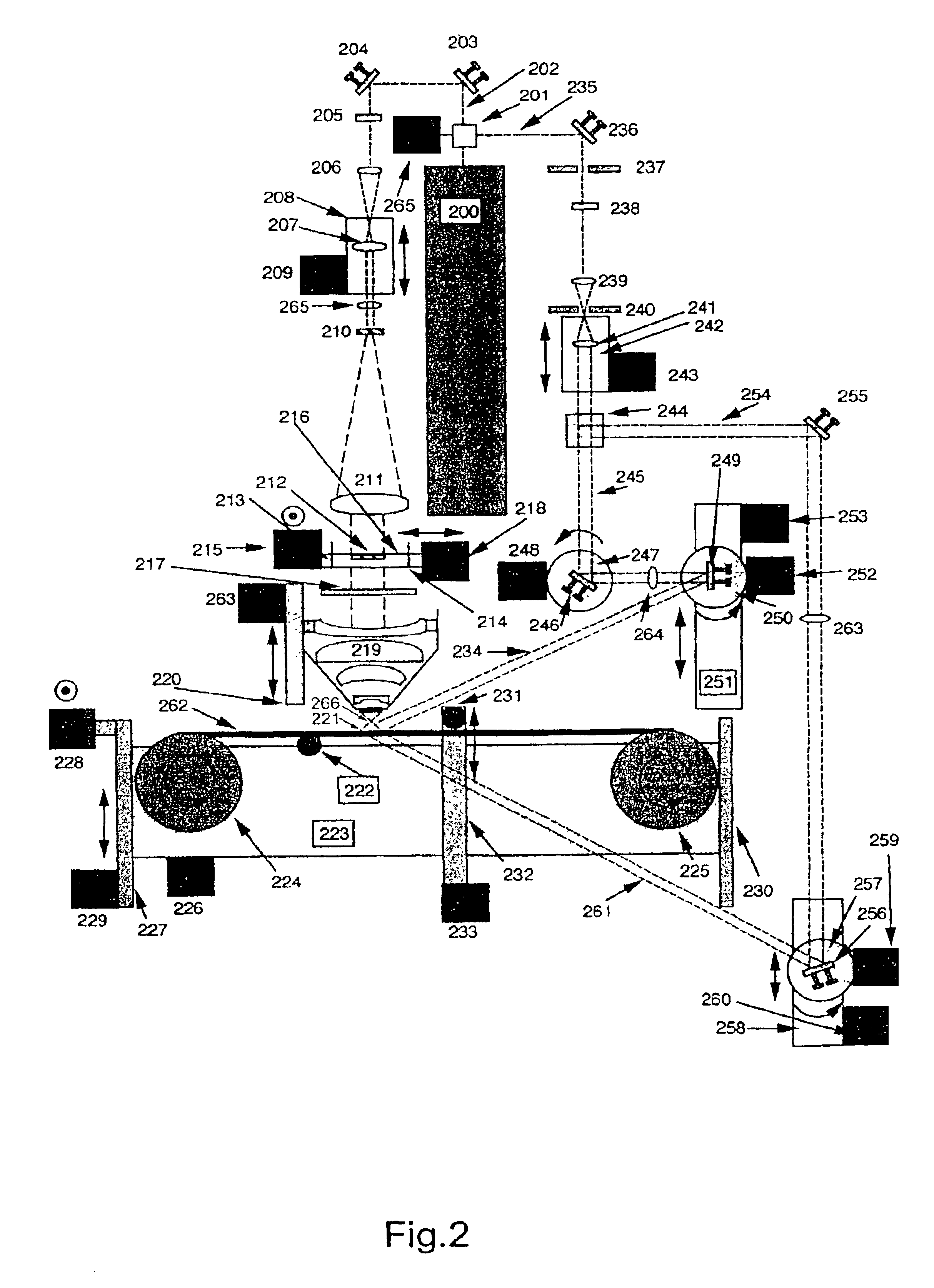For many practical applications this technique is hence unsuitable.
However, even with today's
computer resources, calculation of the interference pattern by Fourier transforms remains a daunting computational task for larger holograms.
In addition it is still highly difficult and costly to write such patterns once calculated, the preferred technique being by
electron beam.
However, this latter
system suffered from the
disadvantage that the image should be located very close to the recording material.
Additionally, the
system was unable to form holograms which faithfully reconstructed the directional properties of light emanating from each image point.
Foremost the use of a
CW laser severely limits the write time of each holographic pixel.
In addition air currents, temperature changes and environmental sound will generally disturb the proper operation of such a printer.
Hence, the arrangement suffers from a low printing speed, and it is not practically possible to implement such a device outside of a strictly controlled laboratory environment.
Another
disadvantage of the above
system is that it can only produce holographic pixels of one size.
Such a system is not therefore able to continuously change the holographic pixel size and hence different formats of holograms which require fundamentally different pixel sizes can not be readily produced.
The use of contact apertures 1618, 1622 in the system, apart from being inflexible, is also highly problematic since the
emulsion surface of the photosensitive material is very sensitive.
Another
disadvantage of this arrangement is that it is only designed to produce monochromatic reflection type holograms.
The system is also unable to produce master H1 type holograms, and is similarly incapable of producing any form of multiple colour hologram.
Another disadvantage of the above system is that the wide-angle objective 1617 employed is designed to only minimize
spherical aberration, is simplistic in design and only allows a restricted set of holographic formats to be produced.
Another disadvantage of the system is that the
reference beam angle is fixed and cannot be controlled as may be required, for instance, to arrange for different hologram replay conditions.
As is readily apparent, the above described holographic printer suffers from numerous problems which render it impractical to use commercially.
In addition, for large holograms, the time required to write a two dimensional array of holographic pixels is usually proportional to the square of the time required to write the H1 master hologram and as such can become prohibitively long for some applications.
Furthermore, a frequent complaint of directly written 1-step composite holograms is that the holograms appear “pixelated” whereas the 2-step technique of using an H1 master hologram is less prone to this problem.
Also in many applications quick previews of the final hologram are required and it is not generally convenient to produce an H1 hologram and then to put this hologram into another
machine in order to generate the final H2 hologram.
Known 1-step and 2-step holographic printing processes employ CW lasers and thus, as a result, conventional holographic printing technology has been fundamentally slow and prone to vibrational disturbance.
There are many disadvantages of this system.
In addition air currents, temperature changes and environmental sound will generally disturb the proper operation of such a printer.
Hence the system suffers from a low printing speed and it is impractical to use such a device outside of a strictly controlled laboratory environment.
Another disadvantage of this holoprinter is that a
diffusion screen is utilized onto which 2-D perspective view images are projected.
However a powerful
laser is undesirable due to the problems of thermal heating of the various optical components, particularly the film 33, which must remain interferometrically static during each and every
exposure.
Long
exposure times are undesirable because of problems due to vibration.
Another disadvantage of the above system is that a
diffusion screen, aside from being energetically inefficient, inevitably deteriorates the
image quality.
Another disadvantage of the above system is that a
point source is used to illuminate the film transparency and thus the final image fidelity will be severely limited.
Another disadvantage of the above system is that a large moving aperture must move in quasi-contact with the photosensitive
emulsion surface.
This is usually very problematic as the
emulsion of the photosensitive material 60 is usually highly fragile and yet if the aperture 58 is held at more than a very small distance from said emulsion surface then the quality of the generated hologram will rapidly fall.
A yet further disadvantage of the above arrangement is that the moving aperture will inevitably leave areas of the hologram which are either doubly exposed or unexposed, thus diminishing the quality.
Another disadvantage of the above arrangement is that it is only capable of making H1 type holograms and cannot directly write 1-step white-light-viewable holograms where the 3-D object bisects the hologram plane.
A further disadvantage of the above arrangement is that it is only capable of reasonably writing single
parallax holograms as generalization of the technique to full
parallax would render the technique hopelessly cumbersome given the above cited problems.
 Login to View More
Login to View More  Login to View More
Login to View More 


